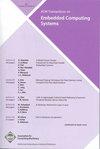APB-tree:基于 NVM 的物联网系统的自适应预建树索引方案
IF 2.8
3区 计算机科学
Q2 COMPUTER SCIENCE, HARDWARE & ARCHITECTURE
引用次数: 0
摘要
近年来,随着传感器的普及和新型应用的出现,物联网数据呈指数级增长。鉴于这一趋势,高效的数据管理对于系统轻松访问海量信息至关重要。几十年来,基于 B + 树的索引方案已被广泛采用,用于在物联网系统中提供有效的搜索。然而,在具有预先分布的传感器的系统中,基于 B + 树的索引无法优化利用已知的物联网数据分布,从而导致大量的写入开销和能耗。此外,随着非易失性存储器(NVM)技术作为替代存储介质的出现,NVM 固有的写入不对称导致了物联网系统的不稳定性问题,尤其是对于写入密集型应用。在本研究中,通过考虑基于树的索引方案的写开销和密钥范围分布假设,我们重新思考了基于树的索引方案的设计,并提出了一种自适应预建树(APB-tree)索引方案,以减少在基于 NVM 的物联网系统中为插入和删除密钥服务时的写开销。APB 树根据已知密钥范围剖析密钥分布的热点区域,预先分配索引结构,从而降低在线索引管理成本和运行时索引开销。同时,APB 树保持了基于树的索引结构的可扩展性,以适应物联网系统新增节点带来的大量新数据。大量实验证明,我们的解决方案在基于 NVM 的物联网系统中保持有效能耗的同时,在写入操作方面实现了显著的性能提升。我们比较了在 APB 树和基于 B + 树的索引方案中进行 Put()、Get() 和 Delete() 等基本密钥操作所需的能量和时间。在这些操作比例各不相同的工作负载下,与基于 B + 树的索引方案相比,所提出的设计能有效缩短 47% 到 72% 的执行时间,降低 11% 到 72% 的能耗。本文章由计算机程序翻译,如有差异,请以英文原文为准。
APB-tree: An Adaptive Pre-built Tree Indexing Scheme for NVM-based IoT Systems
With the proliferation of sensors and the emergence of novel applications, IoT data has grown exponentially in recent years. Given this trend, efficient data management is crucial for a system to easily access vast amounts of information. For decades, B
+
-tree-based indexing schemes have been widely adopted for providing effective search in IoT systems. However, in systems with pre-distributed sensors, B
+
-tree-based indexes fail to optimally utilize the known IoT data distribution, leading to significant write overhead and energy consumption. Furthermore, as non-volatile memory (NVM) technology emerges as the alternative storage medium, the inherent write asymmetry of NVM leads to instability issues in IoT systems, especially for write-intensive applications. In this research, by considering the write overheads of tree-based indexing schemes and key-range distribution assumption, we rethink the design of the tree-based indexing schemes and propose an adaptive pre-built tree (APB-tree) indexing scheme to reduce the write overhead in serving insertion and deletion of keys in the NVM-Based IoT system. The APB-tree profiles the hot region of the key distribution from the known key range to pre-allocate the index structure that alleviates online index management costs and run-time index overhead. Meanwhile, the APB-tree maintains the scalability of a tree-based index structure to accommodate the large amount of new data brought by the additional nodes to the IoT system. Extensive experiments demonstrate that our solution achieves significant performance improvements in write operations while maintaining effective energy consumption in the NVM-based IoT system. We compare the energy and time required for basic key operations like Put(), Get(), and Delete() in APB-trees and B
+
-tree-based indexing schemes. Under workloads with varying ratios of these operations, the proposed design effectively reduces execution time by 47% to 72% and energy consumption by 11% to 72% compared to B
+
-tree-based indexing schemes.
求助全文
通过发布文献求助,成功后即可免费获取论文全文。
去求助
来源期刊

ACM Transactions on Embedded Computing Systems
工程技术-计算机:软件工程
CiteScore
3.70
自引率
0.00%
发文量
138
审稿时长
6 months
期刊介绍:
The design of embedded computing systems, both the software and hardware, increasingly relies on sophisticated algorithms, analytical models, and methodologies. ACM Transactions on Embedded Computing Systems (TECS) aims to present the leading work relating to the analysis, design, behavior, and experience with embedded computing systems.
 求助内容:
求助内容: 应助结果提醒方式:
应助结果提醒方式:


